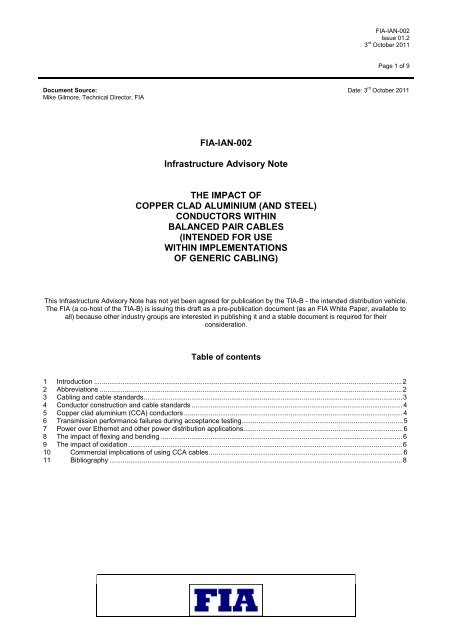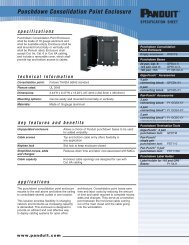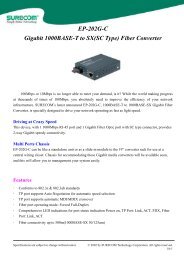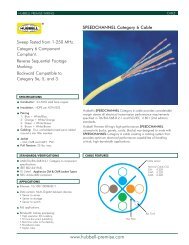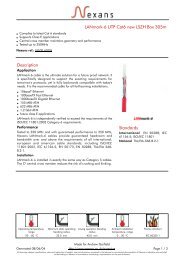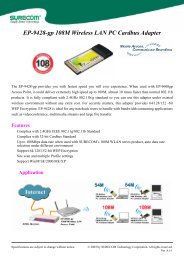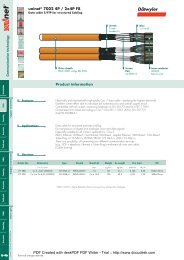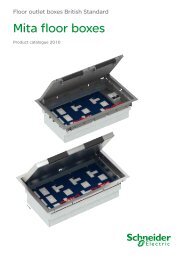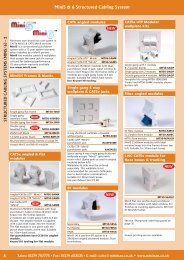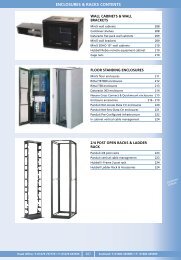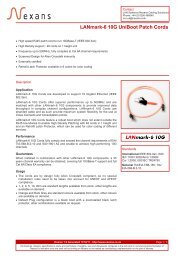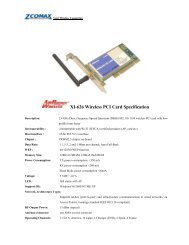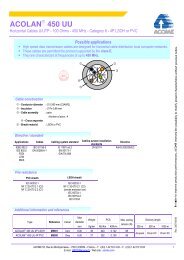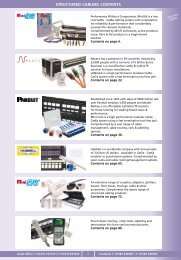FIA White Paper on Copper Clad Aluminium
FIA White Paper on Copper Clad Aluminium
FIA White Paper on Copper Clad Aluminium
You also want an ePaper? Increase the reach of your titles
YUMPU automatically turns print PDFs into web optimized ePapers that Google loves.
<str<strong>on</strong>g>FIA</str<strong>on</strong>g>-IAN-002<br />
Issue 01.2<br />
3 rd October 2011<br />
Page 1 of 9<br />
Document Source: Date: 3 rd October 2011<br />
Mike Gilmore, Technical Director, <str<strong>on</strong>g>FIA</str<strong>on</strong>g><br />
<str<strong>on</strong>g>FIA</str<strong>on</strong>g>-IAN-002<br />
Infrastructure Advisory Note<br />
THE IMPACT OF<br />
COPPER CLAD ALUMINIUM (AND STEEL)<br />
CONDUCTORS WITHIN<br />
BALANCED PAIR CABLES<br />
(INTENDED FOR USE<br />
WITHIN IMPLEMENTATIONS<br />
OF GENERIC CABLING)<br />
This Infrastructure Advisory Note has not yet been agreed for publicati<strong>on</strong> by the TIA-B - the intended distributi<strong>on</strong> vehicle.<br />
The <str<strong>on</strong>g>FIA</str<strong>on</strong>g> (a co-host of the TIA-B) is issuing this draft as a pre-publicati<strong>on</strong> document (as an <str<strong>on</strong>g>FIA</str<strong>on</strong>g> <str<strong>on</strong>g>White</str<strong>on</strong>g> <str<strong>on</strong>g>Paper</str<strong>on</strong>g>, available to<br />
all) because other industry groups are interested in publishing it and a stable document is required for their<br />
c<strong>on</strong>siderati<strong>on</strong>.<br />
Table of c<strong>on</strong>tents<br />
1 Introducti<strong>on</strong>..................................................................................................................................................................2<br />
2 Abbreviati<strong>on</strong>s...............................................................................................................................................................2<br />
3 Cabling and cable standards........................................................................................................................................3<br />
4 C<strong>on</strong>ductor c<strong>on</strong>structi<strong>on</strong> and cable standards...............................................................................................................4<br />
5 <strong>Copper</strong> clad aluminium (CCA) c<strong>on</strong>ductors...................................................................................................................4<br />
6 Transmissi<strong>on</strong> performance failures during acceptance testing.....................................................................................5<br />
7 Power over Ethernet and other power distributi<strong>on</strong> applicati<strong>on</strong>s....................................................................................6<br />
8 The impact of flexing and bending...............................................................................................................................6<br />
9 The impact of oxidati<strong>on</strong>................................................................................................................................................6<br />
10 Commercial implicati<strong>on</strong>s of using CCA cables......................................................................................................6<br />
11 Bibliography..........................................................................................................................................................8
<str<strong>on</strong>g>FIA</str<strong>on</strong>g>-IAN-002<br />
Issue 01.2<br />
3 rd October 2011<br />
Page 2 of 9<br />
1 Introducti<strong>on</strong><br />
The terms Category 5 or Category 5e has become syn<strong>on</strong>ymous with “entry level” 4-pair balanced cables. Many users<br />
and installers have an ambivalent view of what c<strong>on</strong>stitutes these cables. As a result, there is significant pressure <strong>on</strong><br />
pricing which has encouraged the importati<strong>on</strong> of lower cost products in order to boost supply chain margins or to reduce<br />
the capital expenditure of users<br />
This Infrastructure Advisory Note reviews the implicati<strong>on</strong>s of <strong>on</strong>e specific implementati<strong>on</strong> of these low cost products that<br />
claim to be “Category 5” or “Category 5e” using <strong>Copper</strong> <strong>Clad</strong> <strong>Aluminium</strong> (CCA) c<strong>on</strong>ductors. This document supports<br />
many others prepared by suppliers and trade associati<strong>on</strong>s around the world.<br />
NOTE:<br />
the most general of these is the joint press release of March 2011 by the US Communicati<strong>on</strong>s Cable and C<strong>on</strong>nectivity<br />
Associati<strong>on</strong> (CCCA), www.cccassoc.org, and the <strong>Copper</strong> Development Associati<strong>on</strong> (CDA) which “warns of n<strong>on</strong>-compliant<br />
Category cable made with <strong>Copper</strong> <strong>Clad</strong> Aluminum c<strong>on</strong>ductors”. Members include Accu-Tech; AlphaGary; Anixter; Belden;<br />
Berk-Tek, a Nexans Company; Cable Comp<strong>on</strong>ents Group; CommScope; Daikin America; DuP<strong>on</strong>t; 3M; General Cable; Optical<br />
Cable Corporati<strong>on</strong> (OCC); OFS, a Furukawa Company; PolyOne; Sentinel C<strong>on</strong>nector Systems; Solvay Solexis; Superior<br />
Essex; Tyco Electr<strong>on</strong>ics<br />
Cables c<strong>on</strong>taining CCA c<strong>on</strong>ductors masquerade as standards-compliant “Category 5” or “Category 5e” products -<br />
tempting users to specify them and installers to use them.<br />
However, they do not comply with any recognised cable standard in the North America, internati<strong>on</strong>al or European<br />
arenas.<br />
More worryingly, from a c<strong>on</strong>tractual, and therefore potentially financial, sense - when used in generic, structured, cabling<br />
systems in accordance with the various premises-specific versi<strong>on</strong>s of ANSI/TIA-568-C, ISO/IEC 11801 or BS EN 50173<br />
standards - they may:<br />
• fail basic transmissi<strong>on</strong> performance tests during commissi<strong>on</strong>ing acceptance tests;<br />
• exhibit poor flexibility leading to failed c<strong>on</strong>necti<strong>on</strong>s during both installati<strong>on</strong> and operati<strong>on</strong>;<br />
• produce higher than expected temperature rises when used to provide power using applicati<strong>on</strong>s such as Power over<br />
Ethernet (PoE and PoEplus);<br />
• exhibit oxidati<strong>on</strong> of exposed aluminium at points of c<strong>on</strong>necti<strong>on</strong> which may reduce lifetime of those c<strong>on</strong>necti<strong>on</strong>s,<br />
particularly when they are subject to vibrati<strong>on</strong> or other movement.<br />
For these reas<strong>on</strong>s, the Fibreoptic Industry Associati<strong>on</strong> cauti<strong>on</strong> against the use of cables c<strong>on</strong>taining CCA c<strong>on</strong>ductors<br />
within installati<strong>on</strong>s where they replace standards-compliant cables of a specified Category.<br />
Furthermore, the Fibreoptic Industry Associati<strong>on</strong> cauti<strong>on</strong> against the use of cables c<strong>on</strong>taining CCA c<strong>on</strong>ductors as an<br />
alternative to cables of a specified Category (i.e. where the term is not explicitly used but is implicitly indicated as the<br />
intended utilisati<strong>on</strong> of the cable).<br />
2 Abbreviati<strong>on</strong>s<br />
ANSI American Nati<strong>on</strong>al Standards Institute www.ansi.org<br />
AWG<br />
American Wire Gauge<br />
CCA<br />
copper clad aluminium<br />
CENELEC European Committee for Electrotechnical Standardizati<strong>on</strong> www.cenelec.eu<br />
IEEE<br />
www.ieee.org<br />
IEC Internati<strong>on</strong>al Electrotechnical Committee www.iec.ch<br />
ISO<br />
Internati<strong>on</strong>al Standards Organisati<strong>on</strong><br />
ISO/IEC<br />
www.standardsinfo.net<br />
PoE<br />
Power over Ethernet<br />
TIA Telecommunicati<strong>on</strong>s Industry Associati<strong>on</strong> www.tia<strong>on</strong>line.org
<str<strong>on</strong>g>FIA</str<strong>on</strong>g>-IAN-002<br />
Issue 01.2<br />
3 rd October 2011<br />
Page 3 of 9<br />
3 Cabling and cable standards<br />
Balanced cable “Categories” are defined in three separate sets of regi<strong>on</strong>al standards: North American ANSI/TIA-568-C.2,<br />
internati<strong>on</strong>al ISO/IEC 11801 and BS EN 50173-1. While these three standards represent the source of the specificati<strong>on</strong><br />
of cable Categories, the Category system is referred to by many other ANSI/TIA, ISO/IEC and European standards and<br />
those of other bodies such as IEEE.<br />
In the North American standards, Category 5e defines a cable performance, a c<strong>on</strong>necting hardware performance and an<br />
installed cabling performance requirement. In order to produce a Category 5e installed cabling system it is necessary to<br />
use Category 5e comp<strong>on</strong>ents.<br />
NOTE: an equivalent approach exists for the delivery of Category 6 and 6A cabling using Category 6 and 6A comp<strong>on</strong>ents.<br />
In the internati<strong>on</strong>al and European standards, installed cabling is required to meet a transmissi<strong>on</strong> performance Class<br />
c<strong>on</strong>stituting a mix of individual transmissi<strong>on</strong> parameters. One way of meeting the required transmissi<strong>on</strong> performance<br />
Class, called the “reference implementati<strong>on</strong> approach” is to use comp<strong>on</strong>ents of a given Category (there are other<br />
methods of c<strong>on</strong>formance, but most installers will adopt this “reference implementati<strong>on</strong> approach”) as follows:<br />
• Class D installed performance - Category 5 comp<strong>on</strong>ents;<br />
• Class E installed performance - Category 6 comp<strong>on</strong>ents;<br />
• Class E A installed performance - Category 6 A comp<strong>on</strong>ents;<br />
• Class F installed performance - Category 7 comp<strong>on</strong>ents;<br />
• Class F A installed performance - Category 7 A comp<strong>on</strong>ents.<br />
There are small differences in performance between Category 5 and 5e (and between the other similarly named<br />
Categories in North America and internati<strong>on</strong>al standardisati<strong>on</strong>) but these differences are relatively unimportant when<br />
compared to the potential problems caused by CCA c<strong>on</strong>ductors claiming to meet a given Category,<br />
Naturally in order for any of the standards to be viable, the specificati<strong>on</strong> of comp<strong>on</strong>ents has to be well defined in order<br />
that the overall installati<strong>on</strong> meets the desired level of performance. ANSI/TIA and CENELEC (providing European and<br />
British standards) reference their own cable standards whereas ISO/IEC adopt cable standards produced by IEC.<br />
The relevant specificati<strong>on</strong>s are shown in the Table 1 below.<br />
Category Applicati<strong>on</strong> Type North America Europe Internati<strong>on</strong>al<br />
Category 5 Distributi<strong>on</strong> Unscreened EN 50288-3-1<br />
Screened EN 50288-2-1<br />
IEC 61156-5<br />
Flexible Unscreened EN 50288-3-2<br />
Screened EN 50288-2-2<br />
IEC 61156-6<br />
Category 5e Distributi<strong>on</strong> Unscreened<br />
Flexible<br />
Screened<br />
Unscreened<br />
Screened<br />
Category 6 Distributi<strong>on</strong> Unscreened EN 50288-6-1<br />
IEC 61156-5<br />
Screened EN 50288-5-1<br />
Flexible Unscreened<br />
ANSI/TIA-568-C.2<br />
EN 50288-6-2<br />
IEC 61156-6<br />
Screened EN 50288-5-2<br />
Category Distributi<strong>on</strong> Unscreened<br />
EN 50288-11-1 ∗<br />
6A/6 A<br />
Screened EN 50288-10-1 ∗ IEC 61156-5<br />
Flexible Unscreened<br />
EN 50288-11-2 ∗<br />
Screened<br />
EN 50288-10-2 ∗ IEC 61156-6<br />
Category 7 Distributi<strong>on</strong> Screened EN 50288-4-1<br />
Flexible Screened EN 50288-4-2<br />
IEC 61156-5<br />
Category 7 A Distributi<strong>on</strong> Screened EN 50288-9-1 ∗<br />
Flexible Screened EN 50288-9-2 ∗ IEC 61156-6<br />
∗ standards in development (August 2011)<br />
Table 1 - Cable specificati<strong>on</strong>s
<str<strong>on</strong>g>FIA</str<strong>on</strong>g>-IAN-002<br />
Issue 01.2<br />
3 rd October 2011<br />
Page 4 of 9<br />
The cable specificati<strong>on</strong>s are divided into applicati<strong>on</strong> and type. The applicati<strong>on</strong> of the cable is described in Table 1 as<br />
either distributi<strong>on</strong> or flexible. The c<strong>on</strong>cept of a distributi<strong>on</strong> cable is best described as a fixed cable with solid, n<strong>on</strong>stranded,<br />
c<strong>on</strong>ductors used to c<strong>on</strong>nect panels and outlets. The term flexible is sometimes misunderstood assuming that it<br />
means cable for use in the creati<strong>on</strong> of cords and using stranded c<strong>on</strong>ductors. This is not strictly true since flexible cables<br />
can be created using either stranded or n<strong>on</strong>-stranded c<strong>on</strong>ductors. However, cables c<strong>on</strong>structed using stranded<br />
c<strong>on</strong>ductors will tend to exhibit higher resistance and signal attenuati<strong>on</strong> and this is of relevance to this IAN. Therefore, for<br />
purposes of simplicity, we will assume that all flexible cable specificati<strong>on</strong>s relate to stranded c<strong>on</strong>ductors <strong>on</strong>ly.<br />
4 C<strong>on</strong>ductor c<strong>on</strong>structi<strong>on</strong> and cable standards<br />
All the cable specificati<strong>on</strong>s detailed in Table 1 require the c<strong>on</strong>ductors to be of solid copper (whether or not they are<br />
stranded).<br />
Specifically:<br />
• ANSI/TIA-568-C.2 by reference to ANSI/ICEA S-90-661-2006 for Category 5e states that “solid c<strong>on</strong>ductors shall<br />
c<strong>on</strong>sist of commercial pure, annealed, bare copper …” and that, where used “tin coated c<strong>on</strong>ductors shall c<strong>on</strong>sist<br />
of commercially pure, solid annealed copper, tin coated …”;<br />
• IEC 61156 standards state that “the c<strong>on</strong>ductor shall be a solid annealed copper c<strong>on</strong>ductor”;<br />
• EN 50288 standards state that “the c<strong>on</strong>ductor shall be solid copper and comply with the requirements of EN<br />
50288-1:2003” and “the c<strong>on</strong>ductor shall be plain or metal coated” (the latter referring to the use tinned copper).<br />
In fact the latest EN documents in development (marked with an asterisk in Table 1) go even further by<br />
including the additi<strong>on</strong>al text shown in red “the c<strong>on</strong>ductor shall be annealed solid copper and comply with the<br />
requirements of EN 50288-1:2003, 4.1. The c<strong>on</strong>ductor shall be plain or metal coated.<br />
NOTE <strong>Copper</strong> covered (clad) aluminium and/or steel c<strong>on</strong>ductors are not permitted.”<br />
It is therefore very obvious that a c<strong>on</strong>ductor that is not solid copper (whether or not tinned) cannot be used within a cable<br />
that claims to c<strong>on</strong>form to a Category to North American, internati<strong>on</strong>al or European standards.<br />
5 <strong>Copper</strong> clad aluminium (CCA) c<strong>on</strong>ductors<br />
CCA c<strong>on</strong>ductors generally feature a central core of between 60 % and 80 % of the c<strong>on</strong>ductor diameter of aluminium with<br />
the remaining 40% - 20 % being a copper cladding surrounding the aluminium.<br />
Most of the c<strong>on</strong>venti<strong>on</strong>al applicati<strong>on</strong>s of CCA (such as coaxial cables) use the aluminium to reduce the weight and cost<br />
of the cable. The aluminium is a less efficient c<strong>on</strong>ductor than copper, but the higher frequencies associated with data<br />
transmissi<strong>on</strong> are carried within the copper cladding - acting as the “skin” of the c<strong>on</strong>ductor. In such cases the<br />
transmissi<strong>on</strong> performance is provided by the copper, ignoring the aluminium carrier beneath its surface.<br />
In theory, this should provide a CCA-based balanced pair cable with the high frequency performance of a given Category<br />
at a lower cost. However, it is not high frequency performance that causes the principal problem and the use of<br />
aluminium degrades the performance of the solid copper soluti<strong>on</strong> of Category 5/5e cables.<br />
The published IEC and EN cable standards of Table 1 allow c<strong>on</strong>ductor diameters between 0,4 mm and 0,8 mm.<br />
NOTE: The EN standards under development (marked with an asterisk in Table 1) do not allow diameters below 0,5 mm.<br />
However, the cabling standards point out that any diameters outside the range 0,5 mm to 0,65 mm are not suitable for<br />
installati<strong>on</strong> into “sockets” (i.e. the distributi<strong>on</strong> cables of Table 1). In all cases, the maximum dc resistance allowed for a<br />
100 m c<strong>on</strong>ductor is 9,5 Ω.<br />
The North American standards specify a minimum c<strong>on</strong>ductor diameter of 0,51 mm (24 AWG) and a maximum dc<br />
resistance of 9.38 Ω.<br />
The resistivity of annealed copper is 1,72 x 10 -8 whereas the resistivity of aluminium is 2,82 x 10 -8 . The resistance of an<br />
aluminium c<strong>on</strong>ductor is therefore 64% above that of copper c<strong>on</strong>ductor of equal cross-secti<strong>on</strong>al area. The producti<strong>on</strong> of a<br />
composite CCA c<strong>on</strong>ductor produces c<strong>on</strong>ductors that have resistance approximately 40% above the copper equivalent.
<str<strong>on</strong>g>FIA</str<strong>on</strong>g>-IAN-002<br />
Issue 01.2<br />
3 rd October 2011<br />
Page 5 of 9<br />
6 Transmissi<strong>on</strong> performance failures during acceptance testing<br />
Installers are rarely going to attempt to c<strong>on</strong>firm the performance of a cable against a standard at comp<strong>on</strong>ent level. Any<br />
problems of transmissi<strong>on</strong> performance will <strong>on</strong>ly come to light following terminati<strong>on</strong> of the cables - and when acceptance<br />
testing is being undertaken.<br />
The obvious difference between copper and CCA c<strong>on</strong>ductors is DC resistance.<br />
DC loop resistance is a requirement for compliance with the:<br />
• Category 5e, 6 or 6A requirements of permanent links and channels in accordance with ANSI/TIA-568-C.2;<br />
• Class D, E, E A, F and F A requirements of permanent links and channels in accordance with both ISO/IEC 11801<br />
and EN 50173-1.<br />
In both cases the limits are the same i.e. 25 Ω for channels, 21 Ω for worst-case permanent links. The 21 Ω limit<br />
c<strong>on</strong>tains some margin for thermal effects caused by transmitted current since, at 20 o C, 90 metres of Category 5 cable<br />
and three c<strong>on</strong>necti<strong>on</strong>s delvers a loop resistance of 19.6 Ω).<br />
NOTE: DC loop resistance is twice the DC resistance of a c<strong>on</strong>ductor<br />
If the resistance of CCA c<strong>on</strong>ductors is 40% above that of solid copper, permanent links can be expected to be n<strong>on</strong>compliant<br />
for lengths in excess of approximately 80 metres. If the resistance premium of the CCA c<strong>on</strong>ductor is higher or<br />
lower than 40%, the distance at which n<strong>on</strong>-compliance occurs will be shorter or l<strong>on</strong>ger respectively.<br />
DC loop resistance (ohms)<br />
25<br />
20<br />
15<br />
10<br />
5<br />
0<br />
Class D worst-case<br />
permanent link limit (21 W)<br />
0 10 20 30 40 50 60 70 80 90<br />
Link length (m)<br />
Class D (lengthdependent<br />
limit)<br />
Typical Cat.5:2002<br />
Typical CCA<br />
However, this is not the whole story. Basic<br />
compliance with the requirements of ISO/IEC<br />
11801 and BS EN 50173 standards requires<br />
channels to c<strong>on</strong>form to the relevant limits.<br />
However, for DC loop resistance some<br />
c<strong>on</strong>siderati<strong>on</strong> has to be given to the effect of<br />
channel length because when the cable is used<br />
for power feeding all the assumpti<strong>on</strong>s about<br />
cable heating are based up<strong>on</strong> a given power<br />
dissipati<strong>on</strong> per meter. Clearly, if all 25 Ω were<br />
c<strong>on</strong>centrated in a 1 m length, the heating effect<br />
would be massively greater than predicted by the<br />
models used by the standards bodies.<br />
To some extent this problem is resolved by testing permanent links against the true Class requirements of both ISO/IEC<br />
11801 and EN 50173-1 as these requirements are length-based <strong>on</strong> the assumpti<strong>on</strong> of 0,22 Ω per metre for the cable<br />
plus c<strong>on</strong>necti<strong>on</strong>s.<br />
As can be seen in the figure, all lengths of CCA cabling would fail, to varying degrees, when assessed against the<br />
detailed requirements of theses standards.. However, most test equipment does not assess against length-based<br />
calculated limits.<br />
Unfortunately, compliance with the requirements of Category 5e, 6 or 6A requirements of permanent links do not require<br />
this type of length-dependency. This is compounded by the fact that test equipment in accordance with ANSI/TIA-1152,<br />
used to assess compliance with requirements of Category 5e, 6 or 6A requirements of permanent links and channels in<br />
accordance with ANSI/TIA-568-C.2, is <strong>on</strong>ly required to provide informati<strong>on</strong> about DC resistance result i.e. not indicating a<br />
FAIL c<strong>on</strong>diti<strong>on</strong> - even though c<strong>on</strong>formance to cabling standard demands compliance with the relevant limits.<br />
NOTE: This apparent paradox can result is a n<strong>on</strong>-compliant channel or permanent link (in terms of DC resistance) going unnoticed.<br />
To avoid problems resulting from any subsequent oversight, the exact implementati<strong>on</strong> of result presentati<strong>on</strong> needs to be<br />
checked with the test equipment supplier.<br />
However, testing against the requirements of permanent links and channels in accordance with both ISO/IEC 11801 and<br />
EN 50173-1 will automatically register a “FAIL” result if the limits are breached.
<str<strong>on</strong>g>FIA</str<strong>on</strong>g>-IAN-002<br />
Issue 01.2<br />
3 rd October 2011<br />
Page 6 of 9<br />
The AC transmissi<strong>on</strong> parameters of the balanced cables are also affected. Inserti<strong>on</strong> loss/attenuati<strong>on</strong> is also likely to be<br />
flagged under similar c<strong>on</strong>diti<strong>on</strong>s as for DC loop resistance – particularly at lower frequencies.<br />
There are other factors which can affect the intra- and inter-pair noise parameters such as return loss, NEXT and ACR-F<br />
respectively. The comparative lack of physical strength of the c<strong>on</strong>ductor makes it more difficult maintain impedance<br />
c<strong>on</strong>trol during the producti<strong>on</strong> process and also results in misalignment of c<strong>on</strong>ductors within the cable c<strong>on</strong>structi<strong>on</strong>.<br />
These effects are not dependent up<strong>on</strong> installed length and may be exacerbated during and following installati<strong>on</strong>.<br />
7 Power over Ethernet and other power distributi<strong>on</strong> applicati<strong>on</strong>s<br />
The latest standard for Power over Ethernet IEEE 802.3at (sometimes termed PoEplus) increased the current per<br />
c<strong>on</strong>ductor to 300 mA, based up<strong>on</strong> advice from the standards bodies resp<strong>on</strong>sible for ANSI/TIA-568-C.2 and ISO/IEC<br />
11801.<br />
Clearly if the resistance of those c<strong>on</strong>ductors is increased as is the case with CCA implementati<strong>on</strong>s, the thermal impact is<br />
greater. This exacerbates a c<strong>on</strong>cern already being expressed about the use of balanced cables to support currents in<br />
excess of these figures.<br />
CCA will overheat, and quite quickly. For a given applied current, initial temperature increases can be twice those seen<br />
<strong>on</strong> a solid copper c<strong>on</strong>ductor. When the cable does start to overheat a vicious spiral begins and unless the current is<br />
switched off there is no going back to a point of safe working. This could cause extensive damage to the cable and<br />
adjacent cables.<br />
If cords c<strong>on</strong>tain stranded CCA c<strong>on</strong>ductors, the impact <strong>on</strong> heating is further emphasised.<br />
8 The impact of flexing and bending<br />
<strong>Aluminium</strong> has a poor malleability compared to copper; meaning that it will break easily if overworked.<br />
Although distributi<strong>on</strong> cables are generally fixed in positi<strong>on</strong>, there are situati<strong>on</strong>s where they are subject to intermittent but<br />
substantial movement. Examples of such situati<strong>on</strong>s include where distributi<strong>on</strong> cables are fed to untethered sub-floor<br />
boxes and where distributi<strong>on</strong> cables are installed between those floor boxes and furniture-based outlets. The flexing that<br />
such cables undergo may result in cracked c<strong>on</strong>ductors - particularly if the areas subjected to flexing are also linked to<br />
areas of oxidati<strong>on</strong> as described in clause 9.<br />
Table 1 c<strong>on</strong>tains a list of specificati<strong>on</strong>s for flexible cables intended for the producti<strong>on</strong> of cords (typically work area cords,<br />
patch cords and equipment cords). The enhanced requirements for flexibility demanded by those specificati<strong>on</strong>s, whether<br />
or not stranded c<strong>on</strong>ductors are used, are difficult (if not impossible) for CCA cables to meet.<br />
9 The impact of oxidati<strong>on</strong><br />
<strong>Aluminium</strong> starts to oxidize as so<strong>on</strong> as it is exposed to the air - such as when insulati<strong>on</strong> displacement c<strong>on</strong>necti<strong>on</strong>s are<br />
employed to terminate the c<strong>on</strong>ductor - either in plug or socket c<strong>on</strong>necti<strong>on</strong>s. The c<strong>on</strong>tact performance of the oxidised<br />
area will quickly deteriorate causing hot spots. The mechanical performance of the oxidised area will also be affected<br />
which can cause the CCA to snap off when subject to vibrati<strong>on</strong> or minor displacement. Repair of such defects frequently<br />
requires the movement of adjacent terminati<strong>on</strong>s resulting in further damage in a “pack-of-cards” sequence.<br />
The operati<strong>on</strong>al downtime can become prohibitive for the user - and maintaining these installati<strong>on</strong>s can be very costly for<br />
an installer.<br />
10 Commercial implicati<strong>on</strong>s of using CCA cables<br />
Installers should not supply CCA cables against c<strong>on</strong>tracts that demand:<br />
• Category-based performance for the cable against North American, internati<strong>on</strong>al or European standards;<br />
• that the installed cabling meets a given Category against ANSI/TIA-568-C.2;<br />
• that the installed cabling meets a given Class against ISO/IEC 11801 or EN 50173-1 (without a significant risk<br />
of failure during acceptance testing).
<str<strong>on</strong>g>FIA</str<strong>on</strong>g>-IAN-002<br />
Issue 01.2<br />
3 rd October 2011<br />
Page 7 of 9<br />
If a user specifies the use of CCA cables then they cannot simultaneously demand Category-based performance for the<br />
cable against North American, internati<strong>on</strong>al or European standards.<br />
If a user specifies the use of CCA cables then they cannot simultaneously request that the installed cabling meets a<br />
given Category against ANSI/TIA-568-C.2.<br />
If a user specifies the use of CCA cables then they cannot simultaneously demand Category-based performance for the<br />
cable or request that the installed cabling meets a given Class against ISO/IEC 11801 or EN 50173-1 without a<br />
significant risk of failure during acceptance testing.<br />
If a user specifies the use of CCA cables then the installer needs to formally advise the user that the installati<strong>on</strong> should<br />
not be used to support Power over Ethernet or other power supplies due to the probable excessive heating that may<br />
result.<br />
If a user is unaware of the use of CCA cables within an installati<strong>on</strong>, it is very probable that they will find out due to the<br />
significant quantity of failures during acceptance testing. This could result in demands for replacement of the entire<br />
installati<strong>on</strong> and/or litigati<strong>on</strong> <strong>on</strong> the basis of breach of c<strong>on</strong>tract.
<str<strong>on</strong>g>FIA</str<strong>on</strong>g>-IAN-002<br />
Issue 01.2<br />
3 rd October 2011<br />
Page 8 of 9<br />
11 Bibliography<br />
ANSI/TIA-568-C-2<br />
Balanced Twisted-Pair Telecommunicati<strong>on</strong>s Cabling and Comp<strong>on</strong>ents Standards<br />
ANSI/TIA-1152<br />
Requirements for Field Test Instruments and Measurements for Balanced Twisted-<br />
Pair Cabling<br />
ANSI/ICEA S-90-661-2006 Category 3, 5, & 5e Individually Unshielded Twisted Pair Indoor Cables (With<br />
or Without an Overall Shield) for Use in General Purpose and LAN Communicati<strong>on</strong> Wiring<br />
Systems Technical Requirements, 2006<br />
BS EN 50173-1<br />
Informati<strong>on</strong> technology - Generic cabling systems - Part 1: General requirements<br />
EN 50288-1 Multi-element metallic cables used in analogue and digital communicati<strong>on</strong> and c<strong>on</strong>trol –<br />
Part 1: Generic specificati<strong>on</strong><br />
EN 50288-2-1 Multi-element metallic cables used in analogue and digital communicati<strong>on</strong> and c<strong>on</strong>trol -<br />
Part 2-1: Secti<strong>on</strong>al specificati<strong>on</strong> for screened cables characterized up to 100 MHz -<br />
Horiz<strong>on</strong>tal and building backb<strong>on</strong>e cables<br />
EN 50288-2-2 Multi-element metallic cables used in analogue and digital communicati<strong>on</strong> and c<strong>on</strong>trol -<br />
Part 2-2: Secti<strong>on</strong>al specificati<strong>on</strong> for screened cables characterised up to 100 MHz - Work<br />
area and patch cord cables<br />
EN 50288-3-1 Multi-element metallic cables used in analogue and digital communicati<strong>on</strong> and c<strong>on</strong>trol -<br />
Part 3-1: Secti<strong>on</strong>al specificati<strong>on</strong> for unscreened cables characterised up to 100 MHz -<br />
Horiz<strong>on</strong>tal and building backb<strong>on</strong>e cables<br />
EN 50288-3-2 Multi-element metallic cables used in analogue and digital communicati<strong>on</strong> and c<strong>on</strong>trol -<br />
Part 3-2: Secti<strong>on</strong>al specificati<strong>on</strong> for unscreened cables characterised up to 100 MHz -<br />
Work area and patch cord cables<br />
EN 50288-4-1 Multi-element metallic cables used in analogue and digital communicati<strong>on</strong> and c<strong>on</strong>trol -<br />
Part 4-1: Secti<strong>on</strong>al specificati<strong>on</strong> for screened cables characterised up to 600 MHz -<br />
Horiz<strong>on</strong>tal and building backb<strong>on</strong>e cables<br />
EN 50288-4-2 Multi-element metallic cables used in analogue and digital communicati<strong>on</strong> and c<strong>on</strong>trol -<br />
Part 4-2: Secti<strong>on</strong>al specificati<strong>on</strong> for screened cables characterised up to 600 MHz - Work<br />
area and patch cord cables<br />
EN 50288-5-1 Multi-element metallic cables used in analogue and digital communicati<strong>on</strong> and c<strong>on</strong>trol -<br />
Part 5-1: Secti<strong>on</strong>al specificati<strong>on</strong> for screened cables characterized up to 250 MHz -<br />
Horiz<strong>on</strong>tal and building backb<strong>on</strong>e cables<br />
EN 50288-5-2 Multi-element metallic cables used in analogue and digital communicati<strong>on</strong> and c<strong>on</strong>trol -<br />
Part 5-2: Secti<strong>on</strong>al specificati<strong>on</strong> for screened cables characterized up to 250 MHz - Work<br />
area and patch cord cables<br />
EN 50288-6-1 Multi-element metallic cables used in analogue and digital communicati<strong>on</strong> and c<strong>on</strong>trol -<br />
Part 6-1: Secti<strong>on</strong>al specificati<strong>on</strong> for unscreened cables characterised up to 250 MHz -<br />
Horiz<strong>on</strong>tal and building backb<strong>on</strong>e cables<br />
EN 50288-6-2 Multi-element metallic cables used in analogue and digital communicati<strong>on</strong> and c<strong>on</strong>trol -<br />
Part 6-2: Secti<strong>on</strong>al specificati<strong>on</strong> for unscreened cables characterised up to 250 MHz -<br />
Work area and patch cord cables<br />
EN 50288-9-1 Multi-element metallic cables used in analogue and digital communicati<strong>on</strong>s and c<strong>on</strong>trol -<br />
Part 9-1: Secti<strong>on</strong>al specificati<strong>on</strong> for screened cables characterised up to 1 000 MHz -<br />
Horiz<strong>on</strong>tal and building backb<strong>on</strong>e cables<br />
EN 50288-9-2 Multi-element metallic cables used in analogue and digital communicati<strong>on</strong>s and c<strong>on</strong>trol -<br />
Part 9-2: Secti<strong>on</strong>al specificati<strong>on</strong> for screened cables characterised up to 1 000 MHz -<br />
Work area and patch cord cables<br />
EN 50288-10-1 Multi-element metallic cables used in analogue and digital communicati<strong>on</strong> and c<strong>on</strong>trol -<br />
Part 10-1: Secti<strong>on</strong>al specificati<strong>on</strong> for cables characterized up to 500 MHz - Horiz<strong>on</strong>tal and<br />
building backb<strong>on</strong>e cables<br />
EN 50288-10-2 Multi-element metallic cables used in analogue and digital communicati<strong>on</strong> and c<strong>on</strong>trol -<br />
Part 10-2: Secti<strong>on</strong>al specificati<strong>on</strong> for cables characterized up to 500 MHz - Work area and<br />
patch cord cables<br />
EN 50288-11-1 Multi-element metallic cables used in analogue and digital communicati<strong>on</strong> and c<strong>on</strong>trol -<br />
Part 11-1: Secti<strong>on</strong>al specificati<strong>on</strong> for un-screened cables, characterised up to 500 MHz,<br />
for horiz<strong>on</strong>tal and building backb<strong>on</strong>e wiring<br />
EN 50288-11-2 Multi-element metallic cables used in analogue and digital communicati<strong>on</strong> and c<strong>on</strong>trol -
<str<strong>on</strong>g>FIA</str<strong>on</strong>g>-IAN-002<br />
Issue 01.2<br />
3 rd October 2011<br />
Page 9 of 9<br />
Part 11-2: Secti<strong>on</strong>al specificati<strong>on</strong> for un-screened cables, characterised up to 500 MHz -<br />
Work area and patch cord cables<br />
IEC 61156-5 Multicore and symmetrical pair/quad cables for digital communicati<strong>on</strong>s - Part 5:<br />
Symmetrical pair/quad cables with transmissi<strong>on</strong> characteristics up to 1 000 MHz -<br />
Horiz<strong>on</strong>tal floor wiring - Secti<strong>on</strong>al specificati<strong>on</strong><br />
IEC 61156-6 Multicore and symmetrical pair/quad cables for digital communicati<strong>on</strong>s - Part 6:<br />
Symmetrical pair/quad cables with transmissi<strong>on</strong> characteristics up to 1 000 MHz - Work<br />
area wiring - Secti<strong>on</strong>al specificati<strong>on</strong><br />
ISO/IEC 11801<br />
Informati<strong>on</strong> technology - Generic cabling for customer premises


